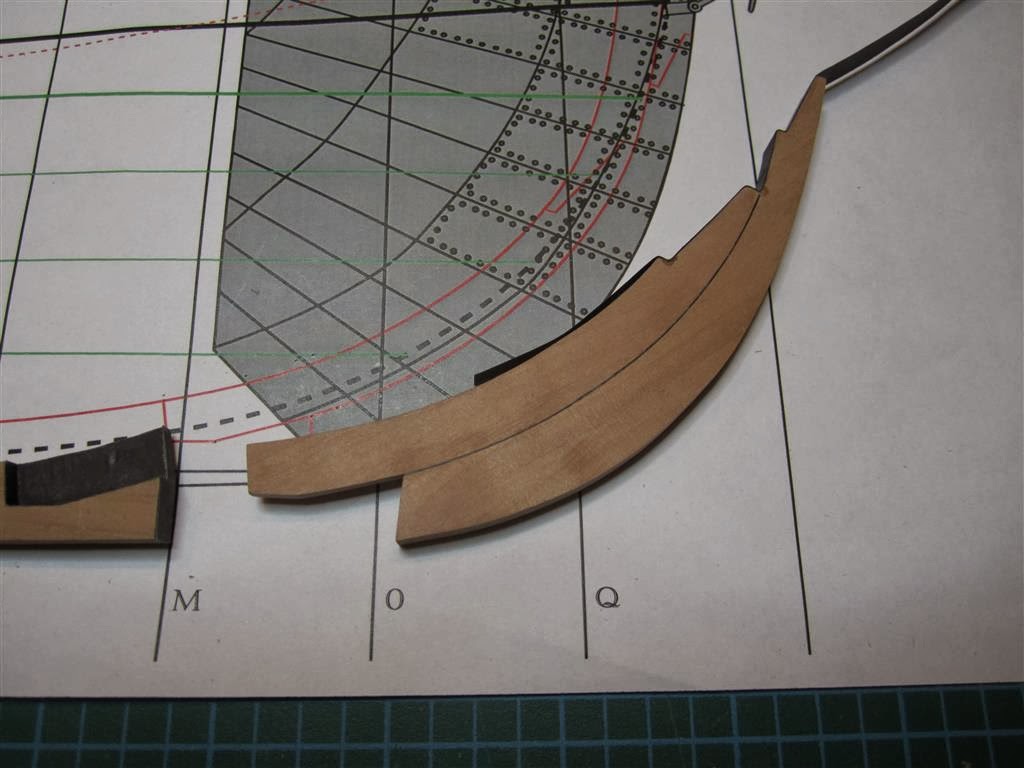.JPG) |
| Completed bow timbers compared to sheet plans. |
Nowhere is the strength of HMS
Terror’s frame more evident than in her bow architecture. Already stoutly built
as a bomb vessel, Terror’s 1836/1837 plans indicate that the bow was
significantly altered for conversion to polar service. The 1836 deck plans show
that her stem was sided 12 and ½ inches, the same as her keel, but it was much
thicker/deeper than normal. In fact, its moulded depth was greater than a vessel
three times her tonnage (see scantlings below). This robustness was also transferred
to her apron, which was consistent in size with that used on a 36 gun frigate.
Terror’s external bow timbers were
also modified in 1836; all ornamentation pieces were removed, as were the
cheeks, forefoot, bobstay piece, gammoning, and lacing. In their place, a very
robust and simplified architecture was installed which consisted of a gripe,
stem piece, main piece, and a short chock to support the bowsprit. Again, these
pieces were very robustly built, and were sided the same as the keel,
diminishing to only 10 inches at the fore edge.
Aft of these bow timbers, the stemson
was similarly solid, sided the same as the stem and just as thick. However, in
1836, the stemson itself was reinforced by massive oak chocks the same width as
the stem, but this time up to 16 inches thick. At the position of the third
waterline, this effectively created a single massive block of wood, 12 and ½
inches wide and extending from the stem piece more than eight feet aft. Indeed, it was strengthening like this that
permitted Crozier to use the Terror as an icebreaker during the Antarctic
voyage of 1839 (Ross 1847:147).
Scantlings for Terror’s Stem and
Apron:
Stem
Sided:
At Head (same as the keel) = 12 and ½
inches At the Heel = 12 and ½ inches (larger than vessels of her size)
Number of pieces = 2
Moulded Depth = 16 inches (larger than
36 gun frigate)
Scarphs in length = 3 feet 9 inches
(boxing) and 3 feet (upper)
Lips of the scarphs = 3 inches
(consistent with standards for a 12 and ½ inch sided keel)
Bolts = 8 (consistent with 76 gun
vessel, standard for bomb vessels)
Bolt diameters = 1 and 1/8 inches
(consistent with 36 and 74 gun vessels, standard for bomb vessels)
Sided (same as the stem) = 12 and ½
inches
Moulded depth = 9 inches (consistent
with 36 gun frigate)
Moulded depth diminishing to the head
= 7 inches
Sided (all pieces):
Aft part of knee (same as the stem) =
12 and ½ inches
Diminishing to the fore = 10 inches Lower scarph in length = 2 feet and 1 inch
Upper scarph in length = 4 feet 2
inches
References:
Ross, Sir James Clark
1847 A
Voyage of Discovery and Research in the Southern and Antarctic Regions, During
the Years 1839-1843: Volume I. John Murray, London.  |
| Sanding the lower stem piece to size. |
 |
| Shaping the upper stem piece. |
 |
| Finished stem and gripe (vellum simulates tarred flannel used on a real ship). |
 |
| Finished main piece and chock to support bowsprit. |
 |
| Detail of scarph joints. |
 |
| Main piece joined to stem piece. |
 |
| Port side view (note that the fore edge has not yet been shaped). |
No comments:
Post a Comment